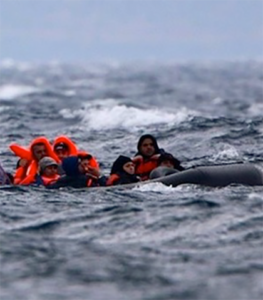Mediterranean drownings decline – IOM
Nearly 1,300 migrants drowned in the Mediterranean in 2019 – a 44 per cent drop on the number of deaths in 2018, according to new data from the International Organisation for Migration (IOM).
The 1,282 drownings in 2019 brought the number of deaths since 2014 to 19,164.
 On the most dangerous route, between Libya and Italy, one migrant in 33 drowned last year compared to a one in 35 ratio in 2018 and one in 51 in 2017, the IOM experts said.
On the most dangerous route, between Libya and Italy, one migrant in 33 drowned last year compared to a one in 35 ratio in 2018 and one in 51 in 2017, the IOM experts said.
The number of migrants who came to Europe by sea in 2019 was 110,669, five per cent down on the previous year.
Arrivals in 2019 nearly halved in Italy while they doubled in Greece compared to the previous year, IOM said.
Arrivals in Italy in 2019 were 11,471, down from the over 181,000 recorded in 2016, 119,000 in 2017 and 23,370 in 2018, when the government said it was closing Italian ports to migrants, according to data released by IOM.
Arrivals in Greece in 2019 nearly doubled to 62,445 compared to 32,742 the previous year, when landings remained stable from 2017 after the exodus of some 854,000 people registered in 2015, in the midst of the Syrian crisis, and the 174,000 individuals recorded in 2016.
Although the number of deaths recorded fell, the figures do not include a rising number of shipwrecks still yet to be confirmed, IOM said.
While the number of migrant deaths recorded in the Mediterranean is down in 2019 compared to previous years, IOM said its records indicate that hundreds of lives were lost without a trace this year.
”These ‘ghost boats’ – vessels reported missing en route to Europe for which no hard evidence can be found – have become increasingly frequent since the search and rescue presence of European and non-governmental actors fell in mid-2017”, the IOM said.
Meanwhile, the EU border agency Frontex reported that irregular migration into the European Union has fallen to its lowest annual level since 2013, despite the significant increase in the number of arrivals to Greece.
Frontex said that according to preliminary figures for 2019, irregular crossings detected on the bloc’s external borders fell by 6 per cent to just over 139,000 – about 92 per cent down on the record number set during the 2015 European migration crisis.
The decline was primarily due to significant falls in the numbers of people reaching European shores via the central and western Mediterranean routes, the agency said, while the eastern Mediterranean route saw a corresponding increase.
About 14,000 people, mostly from Tunisia and Sudan, used the central Mediterranean route from North Africa – mainly Libya – to Italy and Malta, a 41 per cent decline. Those taking the western Mediterranean route, mostly Moroccans and Algerians crossing into Spain, dropped by 58 per cent to 24,000.
But the eastern Mediterranean route into Greece saw “growing migratory pressure” from spring until September, Frontex said, with more than 82,000 irregular migrants detected on the route in 2019 – a 46 per cent increase on the previous year.
Overall, Afghan nationals accounted for almost a quarter of all irregular arrivals in 2019, Frontex said, almost three times as many as in the previous year. There were also more women and children than in recent years.












